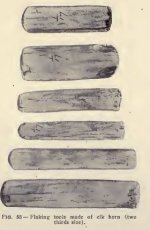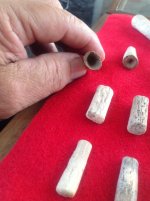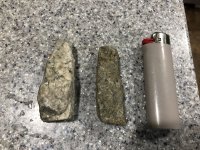Implements Used in Flaking Knives - The specimens shown in Fig- 53 were no doubt used in flaking the large flint knives so common in the village. The flaking tools were always made of deer and elk horn, and varied in length from one and one-half inches to four inches, and in diameter from one-half inch to three-fourths inch. One end is square, while the other end is oval, the longest point being in the middle of the specimen. The square end on almost all the specimens shows a splintered and battered condition, indicating that the implement had been struck with a heavy blow. The oval end also frequently shows a splintered condition, caused by improperly placing the tool against the flint, and striking the blow. The flaking tools are found everywhere in the village, especially in the sites of the tepees and in the graves.


Amazon Forum Fav 👍
Upvote
0







